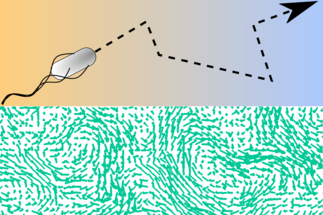Biophysics of environment sensing by motile microorganisms
Dr. Remy Colin
Research Area
The ability to move and navigate in the environment is a major player of the emergence of the complex organization of microbial populations in natural environments. Examples range from aggregation into surface attached biofilms, which may comprise one or several co-habiting species, to the propagation as a dense group on surfaces, known as swarming, or the dispersion in a new environment. Our works aim to elucidate bio-physical principles that govern the organization of bacterial populations under the most common mode of bacterial motility, flagella-based swimming.
Using microscopy, microfluidics and image analysis, combined with numerical analysis, we are currently pursuing two lines of research:
- How the physics of swimming allows for the emergence of complex population organization, by driving bacterial suspensions out of equilibrium, notably via hydrodynamic interactions between swimmers, non-motile cells and surfaces.
- How large cell-to-cell and temporal variability in swimming behaviors emerge even in clonal populations from the properties of the chemotaxis pathway, the bacterial “sense of smell” which controls swimming, and how this modulates global population organization in complex environments.

Selected publications
S. Espada Burriel and R. Colin Active density pattern formation in bacterial binary mixtures. PRX Life (2024) 2, 023002, doi: 10.1103/PRXLife.2.023002
R. Colin*, K. Drescher and V. Sourjik,*, Chemotactic behavior of Escherichia coli at high cell density, Nature Communications (2019) 10, 5329 doi:10.1038/s41467-019-13179-1
R. Colin1,*, C. Rosazza1, A. Vaknin and V. Sourjik* Multiple sources of slow activity fluctuations in a bacterial chemosensory network. eLife (2017) 6, e26796, doi:10.7554/eLife.26796
R. Colin and V. Sourjik Emergent properties of bacterial chemotaxis pathway. Current Opinion in Microbiology (2017) 39, 24, doi: 10.1016/j.mib.2017.07.004
L. Laganenka, R. Colin and V. Sourjik, Chemotaxis towards autoinducer 2 mediates autoaggregation in Escherichia coli, Nature Communications (2016) 7, 12984, doi:10.1038/ncomms12984
R. Colin*, R. Zang and L.G. Wilson, Fast, high-throughput measurement of collective behaviour in a bacterial population, Journal of the Royal Society Interface (2014) 11, 20140486, doi:10.1098/Rsif.2014.0486





